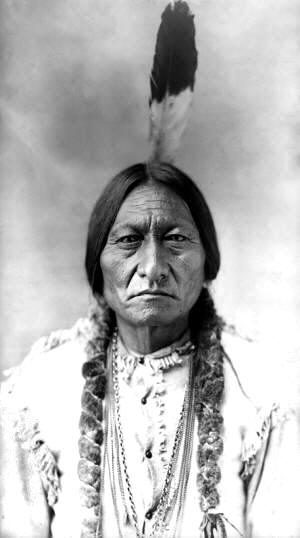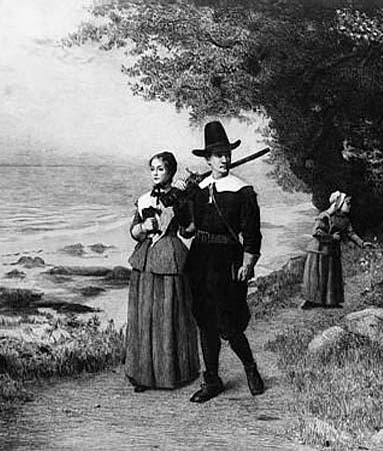Revolutionary Changes
Contact between Native Americans and Europeans between the founding of Jamestown (1607) and the outbreak of the American Revolution (1776) constituted a continuous cultural revolution for native people. The sources used in the writing of this essay were Native Tech.org, The Earth Shall Weep by James Wilson, Wikipedia.com, Pilgrim Hall.org, Sparknotes. com, Merriam Websters Online Dictionary, and Google Images.

Once the Europeans and the French had set foot upon the Native American soil, life for the natives took a turn for the worst. It would be safe to say that it was a revolutionary time period. Nothing in their lives stayed the same. Their religions began to slowly change, their trade was overtaken, and all out war ensued on more than one occasion. Each side had a different reason for entering the wars. For the Europeans and Frenchmen for the most part they were fighting for ownership, whereas the Native Americans were almost always fighting to maintain their freedoms.

In 1620 the Pilgrims landed in Plymouth. They were not the first settlers to come to the area. No, that title belonged to the settlers of Jamestown who arrived in 1607. The Pilgrims had fled from their homeland for several reason but one of the biggest of the few was religion. They were seeking freedom from the laws of England so that they could practice under their own religions without being persecuted. In 1630 another group of people sailed over from England. These were the Puritans and this movement was called the Great Migration. They had all had the same motives in mind when they had left England. They left solely to practice their religion. Unlike the Pilgrims the Puritans still held out hope to return to England someday. They hoped that the country would mend its evil ways.

By 1630 when the Puritans arrived it would be safe to state that the Native Americans were completely surrounded by a new religion and new ideas. These people soon began to force their ideas upon the natives. The Europeans had brought many diseases over with them from England and the natives were especially susceptible. They began to fall like flys and the remaining few saw it as a sign from heaven that they had not been worshipping properly. However, these Europeans just seemed to continue coming over on boats being replenished by an invisible source. The Native Americans attributed this to their religion and soon some began to consider conversion into Christianity.

By 1650 new establishments were founded. These were called Praying Towns. These were places where Christian Indians could reside. The Native Americans that resided here were often referred to as "Praying Indians". In a Praying Town the natives were forced to renounce their native language, ceremonies, beliefs, traditional dress and customs. In short they were converted into mini Europeans. These were the rules of the Praying Towns: "If any man shall be idle a week, or at most a fortnight, he shall be fined five shillings. If any unmarried man shall lie with a young woman unmarried, he shall be fined five shillings. If any man shall beat his wife, his hands shall be tied behind him, and he shall be carried to the place of justice to be punished severely. Every young man, if not anothers servant, and if unmarried, shall be compelled to set up a wigwam, and plant for himself, and not shift up and down in other wigwams. If any woman shall not have her hair tied up, but hang loose, or be cut as a man's hair, she shall pay five shillings. If any woman shall go with naked breasts, she shall pay two shillings. All men that shall wear long locks, shall pay five shillings. If any shall crack lice between their teeth, they shall pay five shillings." In short it does not seem that Praying Towns were such an awful place to live if you did not mind remaining clothed and keeping lice out of your mouth.
Throughout the entire ordeal between the natives and the Europeans and Frenchmen people were always trading. After the Great Migration the natives were able to trade some with the Puritans. However, for the most part the Puritans saw the native peoples as heathens and unworthy of the ground that they walked on. Perhaps, fur was the most highly traded object. The Pilgrims traded with the Indians more than any other culture. They would trade back and forth for corn and fishing privileges as well.

The worst outcome of trade would have to be seen as the Compulsory Purchase. This took place in Jamestown. The Compulsory Purchase was a system developed under the leadership of John Smith. If the Indians refused to sell their corn then the men of Jamestown would take it by force. This was a reasonably easy task because the Indians used the skill of archery and the Europeans had firearms. At this John Smith wrote "I durst undertake to have corne enough from the Salvages for 300 men, for a few trifles. And if they should be untoward (as it is most certaine they are) thirty or forty good men should be enough to bring them all in." Often times because of this the Native Americans had to go hungry themselves and could not plant for the next year because they did not have enough seed. Thus wrecking trade forever in the eyes of the Native Americans.

There were three major wars between the Europeans and Frenchmen with the Indians. The Pequot War, King Philips War, and the French and Indian War. The Pequot War took place between 1637 and 1638 with the Native Americans versus the Pilgrims. Of course the Pilgrims used their superior pieces of technology to win. Many Pequots were harmed in this time of war. The Pequot people who had survived the war were distributed as slaves. This was the first armed war between the Europeans and the Native Americans in history.

King Philips War was one of the bloodiest wars in history. It ran from 1675-1676. One in ten soldiers on both sides was injured or killed. It took several years for Plymouth and several of the other colonies to recover from the amounts of damage done to their property. Once again the colonists won. Hundreds of the Native people who had fought with Philip were sold into slavery and the women and children were forced to become servants locally. Several of the Native communities had to begin to adapt to the new ways to survive.

The French and Indian War ran from 1754-1763. This war took more lives than the American Revolution. It involved people on three continents including the Caribbean. It was the direct result of a clash between the French and English over colonies and land and other such matters. It is often considered as a war between the British and the French. This war was eventually the end of the French's political and cultural influence in North America. England gained tons of land and tightened its hold on the continent. This was not a good thing for the Native Americans. Though at this point they had just been stuck between the English and French anyway.

According to Merriam Websters Online Dictionary, the term "revolution" means: "a sudden, radical or complete change; a fundamental change in political organization; the overthrow or renunciation of one government and the substitution of another." This was definitely a revolutionary time period for the Native Americans. However, it was not one that worked at all in their favor. It was one that nearly drove their entire culture into extinction. They completely lost who they were as a culture in the midst of it all. They no longer were all united together under one religion, they could no longer trade properly, and several of them had been made into slaves by the English and Frenchmen. It was a complete cultural revolution for all of them and those who survived it did not fair so well in the end. However, without those awful Englishmen what is known as New England would not currently exist today.
-Ashley Nichols
No comments:
Post a Comment